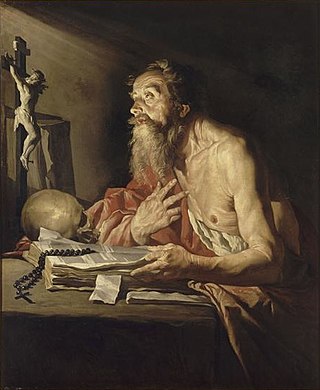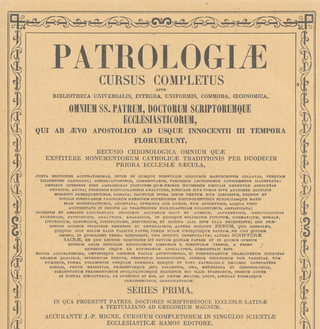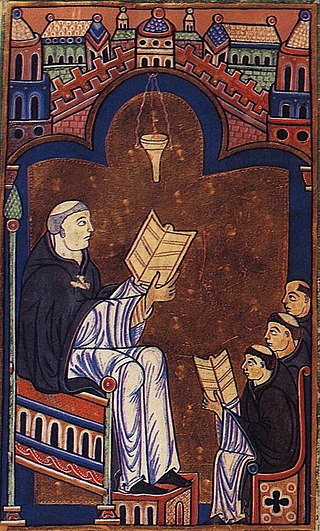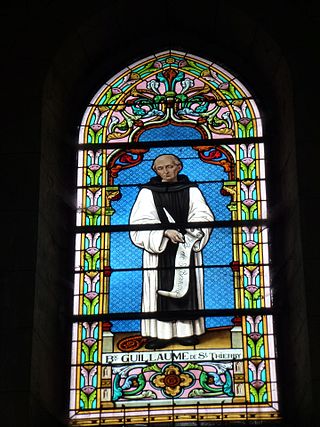Related Research Articles
Eusebius of Caesarea, also known as Eusebius Pamphilius, was a Greek Syro-Palestinian historian of Christianity, exegete, and Christian polemicist. In about AD 314 he became the bishop of Caesarea Maritima in the Roman province of Syria Palaestina.

Jerome, also known as Jerome of Stridon, was an early Christian priest, confessor, theologian, translator, and historian; he is commonly known as Saint Jerome.

Pseudo-Dionysius the Areopagite was a Greek author, Christian theologian and Neoplatonic philosopher of the late 5th to early 6th century, who wrote a set of works known as the Corpus Areopagiticum or Corpus Dionysiacum.
Ratramnus was a Frankish monk of the monastery of Corbie, near Amiens in northern France, and a Carolingian theologian known best for his writings on the Eucharist and predestination. His Eucharistic treatise De corpore et sanguine Domini was a counterpoint to his abbot Paschasius Radbertus’s realist Eucharistic theology. Ratramnus was also known for his defense of the monk Gottschalk, whose theology of double predestination was the center of much controversy in 9th-century France and Germany. In his own time, Ratramnus was perhaps best known for his Against the Objections of the Greeks who Slandered the Roman Church, a response to the Photian schism and defense of the filioque addition to the Niceno-Constantinopolitan Creed. The writings of Ratramnus influenced the Protestant reformation of the 16th century.

Ebionites as a term refers to a Jewish Christian sect that existed during the early centuries of the Common Era, whose name may have been taken from the first group of people mentioned in the Beatitudes of Jesus as blessed and meriting entry in the coming Kingdom of God on Earth.
Theophanes the Confessor was a member of the Byzantine aristocracy who became a monk and chronicler. He served in the court of Emperor Leo IV the Khazar before taking up the religious life. Theophanes attended the Second Council of Nicaea in 787 and resisted the iconoclasm of Leo V the Armenian, for which he was imprisoned. He died shortly after his release.

Epiphanius of Salamis was the bishop of Salamis, Cyprus, at the end of the 4th century. He is considered a saint and a Church Father by both the Eastern Orthodox and Catholic Churches. He gained a reputation as a strong defender of orthodoxy. He is best known for composing the Panarion, a compendium of eighty heresies, which included also pagan religions and philosophical systems. There has been much controversy over how many of the quotations attributed to him by the Byzantine Iconoclasts were actually by him. Regardless of this, he was clearly strongly against some contemporary uses of images in the church.

Rabanus Maurus Magnentius, also known as Hrabanus or Rhabanus, was a Frankish Benedictine monk, theologian, poet, encyclopedist and military writer who became archbishop of Mainz in East Francia. He was the author of the encyclopaedia De rerum naturis. He also wrote treatises on education and grammar and commentaries on the Bible. He was one of the most prominent teachers and writers of the Carolingian age, and was called "Praeceptor Germaniae", or "the teacher of Germany". In the most recent edition of the Roman Martyrology, his feast is given as 4 February and he is qualified as a Saint ('sanctus').

Paschasius Radbertus (785–865) was a Carolingian theologian and the abbot of Corbie, a monastery in Picardy founded in 657 or 660 by the queen regent Bathilde with a founding community of monks from Luxeuil Abbey. His most well-known and influential work is an exposition on the nature of the Eucharist written around 831, entitled De Corpore et Sanguine Domini. He was canonized in 1073 by Pope Gregory VII. His feast day is 26 April.

The Patrologia Latina is an enormous collection of the writings of the Church Fathers and other ecclesiastical writers published by Jacques-Paul Migne between 1841 and 1855, with indices published between 1862 and 1865. It is also known as the Latin series as it formed one half of Migne's Patrologiae Cursus Completus, the other part being the Patrologia Graeca of patristic and medieval Greek works with their medieval Latin translations.

Hugh of Saint Victor was a Saxon canon regular and a leading theologian and writer on mystical theology.

St. Lucifer of Cagliari was a bishop of Cagliari in Sardinia known for his passionate opposition to Arianism. He is venerated as a Saint in Sardinia.
Expositiuncula in Ioannem Evangelistam is a work by the ninth-century Benedictine monk Christian of Stavelot. As its name implies, it is a commentary on the Gospel of John. It is, however, not nearly as comprehensive as his earlier Expositio in Matthaeum Evangelistam.
Exposito in Matthaeum Evangelistam is a work by the ninth-century Benedictine monk Christian of Stavelot. As its name implies, it is a commentary on the Gospel of Matthew. In the preface, Christian promised to produce commentaries on the other gospels, but wrote only two brief works on the Gospel of John and the Gospel of Luke, neither of which is as comprehensive or complete.
Brevis is the Latin word for short, and may refer to:

William of Saint-Thierry, O. Cist was a twelfth-century Benedictine, theologian and mystic from Liège who became abbot of Saint-Thierry in France, and later joined the Cistercian Order.

Claudius of Turin was the Catholic bishop of Turin from 817 until his death. He was a courtier of Louis the Pious and was a writer during the Carolingian Renaissance. He is most noted for teaching iconoclasm, a radical idea at that time in Latin Church, and for some teachings that prefigured those of the Protestant Reformation. He was attacked as a heretic in written works by Saint Dungal and Jonas of Orléans.
Smaragdus of Saint-Mihiel OSB was a Benedictine monk of Saint-Mihiel Abbey near Verdun. He was a significant writer of homilies and commentaries.
Opus Imperfectum in Matthaeum is an early Christian commentary on the Gospel of Matthew, written sometime in the 5th century. Its name is derived from the fact that it is incomplete, omitting a number of passages from Matthew.
References
- 1 2 3 Schaff, Philip. History of the Christian Church. Volume IV: Mediaeval Christianity. A.D. 590-1073. Grand Rapids, MI, 1882. Page 172. Online as Christian Druthmar at CCEL
- ↑ Dunlop, D.M. A History of the Jewish Khazars. Princeton, NJ: Princeton University Press, 1954. ISBN 978-0-8052-0167-3.